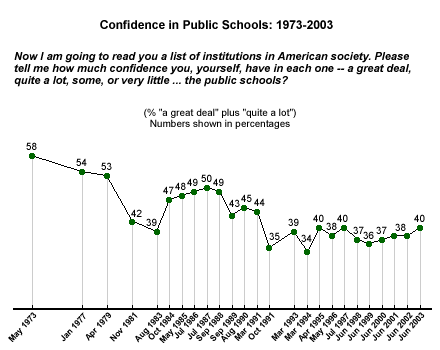In 1973, Gallup began asking Americans to assess their level of confidence in several American institutions, including the public schools. Since that time, groundbreaking educational reforms, increased spending, a broad range of policy initiatives, the emergence of alternative schools, and other innovations have kept the national attention focused on the quality of American education.
But those changes haven't done much for Americans' faith in public schools. According to the most recent Gallup Poll*, when asked, "Please tell me how much confidence you, yourself, have in the public schools," 40% of respondents said they have "a great deal" or "quite a lot" of confidence in them -- down 18 percentage points from its high point of 58% in 1973. The current level of confidence in public schools puts it in the middle of the group of 15 institutions tested, on par with the medical system (44%) and television news (35%), much below the military (82% confidence), but much higher than health maintenance organizations (17%) and big business (22%).

The Decline of Confidence
Compared with the results from 30 years ago, confidence in many American institutions has waned. Besides the public schools, the most notable declines have been seen regarding "the church or organized religion" (overall confidence has fallen from 66% of Americans in 1973, to 50% in 2003), and the U.S. Congress (overall confidence has fallen from 42% in 1973, to 29% today).
Confidence in public schools declined throughout the 1970s, including a large 11-point drop between 1979 and 1981. By August 1983, shortly after the U.S. Department of Education released A Nation at Risk, a chilling report detailing the decline of America's education standards relative to those of other developed nations, confidence had sunk to just 39%. However, like their confidence in a number of other institutions, Americans' faith in public schools rebounded in the mid-1980s, and was at 49% in 1988.
Confidence Levels Stabilize in the 1990s
In 1989, the proportion of Americans with a great deal or quite a lot of confidence in the public schools declined somewhat to 43%. One year later, President George H.W. Bush established the Goals 2000: Educate America Act, in an effort to put public education back on track in eight specific areas: educational readiness of preschool children, school completion, student achievement, teacher education, math and science education, adult literacy, school safety, and parental participation. Despite efforts to improve education in America, the trend hit its all-time low point of 34% in 1994. The following year, the National Education Goals Panel issued a report citing a few successes -- and a number of failures -- in meeting Goals 2000 objectives.
Confidence in the public schools has stabilized at about 40% in the years since 1994, including the current 40% reading. This leveling has occurred despite the fact that immigration and budget crunches have stretched the nation's educational resources very thin in recent years, and despite George W. Bush's significant educational reforms.
Bottom Line
Given the historical trend, it appears as though the federal government's best efforts to improve education have done little to engender Americans' confidence in their public schools. More concrete evidence of improvement may be required to boost confidence levels.
The U.S. Department of Education's annual report, The Condition of Education 2003, presents a mixed bag in that regard. The report states that fourth-graders are outscoring their peers in many other countries on reading items, and there has been an increase since the early 1980s in the percentage of high school graduates completing advanced-level English courses. At the same time, reading literacy scores among 15-year-olds are only average compared to other industrialized countries. Similarly, varied results are seen for mathematics; while math scores for fourth- and eighth-graders increased throughout the 1990s, 12th-graders' scores declined in 2000, and only 17% of 12th-graders score at or above proficiency.
*Findings are based on telephone interviews with a randomly selected national sample of 1,029 adults, 18 and older, conducted June 9-10, 2003. For results based on this sample, one can say with 95% confidence that the maximum error attributable to sampling and other random effects is ±3%.